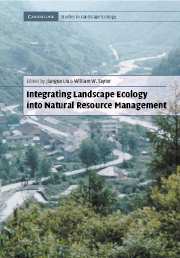Book contents
- Frontmatter
- Contents
- List of contributors
- Foreword
- Preface
- Acknowledgments
- PART I Introduction and concepts
- PART II Landscape structure and multi-scale management
- PART III Landscape function and cross-boundary management
- PART IV Landscape change and adaptive management
- PART V Landscape integrity and integrated management
- 14 Putting multiple use and sustained yield into a landscape context
- 15 Integrating landscape ecology into fisheries management: A rationale and practical considerations
- 16 Applications of advanced technologies in studying and managing grassland landscape integrity
- 17 An integrated approach to landscape science and management
- PART VI Syntheses and perspectives
- Index
- Plate Section
14 - Putting multiple use and sustained yield into a landscape context
Published online by Cambridge University Press: 14 January 2010
- Frontmatter
- Contents
- List of contributors
- Foreword
- Preface
- Acknowledgments
- PART I Introduction and concepts
- PART II Landscape structure and multi-scale management
- PART III Landscape function and cross-boundary management
- PART IV Landscape change and adaptive management
- PART V Landscape integrity and integrated management
- 14 Putting multiple use and sustained yield into a landscape context
- 15 Integrating landscape ecology into fisheries management: A rationale and practical considerations
- 16 Applications of advanced technologies in studying and managing grassland landscape integrity
- 17 An integrated approach to landscape science and management
- PART VI Syntheses and perspectives
- Index
- Plate Section
Summary
Introduction
When managing natural resources, foresters, wildlife biologists, and other practitioners need to consider a vast array of technical information, along with a multitude of values, opinions, and perspectives – many of which may be in conflict and therefore difficult to resolve. Ongoing discussions about ecosystem management, conserving biological diversity, adaptive management, and sustainable development reflect heightened concerns about sustaining natural resources and resolving conflicts among competing interests and demands (e.g., Walters, 1986; Rowe, 1992; Grumbine, 1997; Bunnell, 1998; Tollefson, 1998; Yaffee, 1999).
In response to these and related concerns, the Secretary-General of the United Nations established the World Commission on Environment and Development in 1983, headed by Gro Harlem Brundtland, then Prime Minister of Norway. In their landmark assessment – commonly known as the Brundtland Report – the Commission firmly connected environmental degradation with diminished economic opportunity, human health, and quality of life. In addition, they proposed long-term strategies for achieving sustainable development in a world characterized by great extremes in resource availability and utilization. They suggested multilateral approaches to transcend national sovereignties, political ideologies, and scientific disciplines so that common problems could be identified and common goals pursued.
There is increasing recognition that a more comprehensive and integrated approach is needed to resource planning and management (Boyce and Haney, 1997; Kohm and Franklin, 1997; Vogt et al., 1997). In this chapter, I begin with the premise that principles and concepts from landscape ecology can contribute in a significant way to practicing integrated resource management.
- Type
- Chapter
- Information
- Integrating Landscape Ecology into Natural Resource Management , pp. 349 - 365Publisher: Cambridge University PressPrint publication year: 2002
- 4
- Cited by



